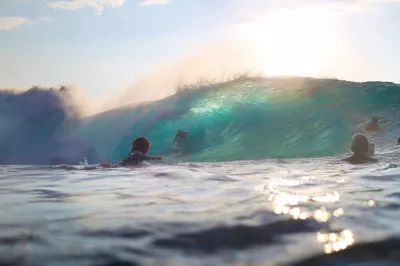Hawaii Is A Surfer's Paradise
Surfers are as much of Hawaii's trademark as hula and palm dancers. After all, surfing was invented in Hawaii. The Hawaiians gave him a philosophy that everyone on the board should learn: it takes time to learn surfing techniques, patience to find the perfect wave and the courage to hit it. Hawaiians sum it up like this: relax. The surfers' greeting literally translates to stay relaxed!
Surfing is a sport that involves riding the waves on a special board - a surfboard. The art of surfing was invented a very long time ago - even half-wild Hawaiians floated on the waves on primitive boards. It was surfing that laid the foundation for such sports as snowboarding or, for example, kitesurfing and windsurfing.
The birthplace of surfing
Surfing was invented by Polynesians who came to Hawaii around 1000 AD from Tahiti and Tonga. In some of the most popular surfing spots, Polynesians have built temples along the coast to pay tribute to the god of waves before diving into the waters. It's no surprise that the birthplace of surfing is Hawaii, because no other archipelago is that far from the mainland. The waves travel thousands of miles across the Pacific Ocean before finding the coast, and as a result, they are very powerful here. Especially in winter, when the Pacific Ocean is restless, they reach heights of over 20 meters.
Surf Ambassador
Godly Christian missionaries who came to Hawaii from the United States in the 19th century banned residents from practicing this sport for a very long time. They were offended by the surfers' nudity and the fact that men and women train together.
It wasn't until the early 20th century that American journalist and traveler Alexander Hume Ford made surfing popular. In 1908, he founded the world's first surfing club on Waikiki Beach. Seven years later, there were already 1,200 people in the club.
The enthusiasm and admiration for the traditional Hawaiian sport was supported by Duke Paoa Kahanamoku. The Waikiki native was more than just an exceptional swimmer - he was great on the board and enjoyed showing off his skills.
In 1912, on the Santa Monica coast, Kahanamoku wowed the American and American media by showcasing his skills on the board. In the same year, he won - this time in swimming - a silver medal at the Stockholm Olympics. Kahanamoku's popularity has grown tremendously, inspiring many to imitate him in the water and on the board. Since then, he has traveled the world as a professional swimmer and has also acted as the unofficial ambassador of surfing. Presumably he was the first to bring surfing to Australia.
Surfing as an attitude to life
With the rise in the number of surfers, the number of surfing competitions has increased. Many surfers wanted the best equipment in order to have the edge. The first to experiment with new techniques in 1926 was swimmer Tom Blake from Wisconsin, USA.
He moved to Hawaii and developed the first longboard here, which was shorter and lighter than its predecessor, weighing over 50 kilograms and over seven meters in length.
In 1931, Blake's invention was put into industrial production. The introduction of light balsa and fiberglass in the 1950s, developed for the aerospace industry, made the boards even lighter and shorter.
Surfing has inspired young people more and more. In the mid-1950s, he expressed a completely new sense of life. Surfers wore Hawaiian shirts, lived in bamboo huts, and played ukuleles. The fun life on the beach was an expression of protest against the conservatism of society. The discovery was the North coast of Oahu, where there were unimaginably high waves, which only very experienced surfers dared to fight. Today, the North Shore is one of the most popular surfing beaches in the world.
World wave
When Hollywood discovered surfing in 1959 with the movie Gidget, the sport became really popular. In two years, the number of surfers worldwide increased from 5,000 to 2 million. Surf factories, surf shops and hotels have sprung up. Surfboards have been further developed using new materials such as foam and polystyrene. From that moment on, everything became possible: any wave, any type of surfing today has its own individually adapted board. There are wide boards for beginners, especially fast boards with a V-shaped underwater hull, and since 1980 surfboards with three fin - or fins - are much more agile and allow for more jumps.
Surfing today is an industry itself, professional surfers make millions with advertising contracts. Hawaii alone hosts three world championships and many smaller events. The winners receive prize money of several hundred thousand dollars. Most of the professionals do not live in Hawaii, but in Australia, the United States and Europe.
The sport is one of the few that has survived to this day from the original Hawaiian culture. For Hawaiians, surfing is more than just a sport, it's a way of life. Because hee nalu - sliding on the waves - also means the way to oneself.
Frequently Asked Questions
- What aspects of Hawaii make it a surfer's paradise, and what range of surfing experiences does it offer?
- Hawaii is a surfer’s paradise due to its perfect waves, warm waters, and rich surfing history. It offers a range of experiences from beginner-friendly spots to world-class big wave surfing locations, making it ideal for surfers of all levels.

